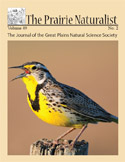Great Plains Natural Science Society

The Prairie Naturalist
Date of this Version
2019
Document Type
Article
Citation
The Prairie Naturalist • 51(1): June 2019, pp 30-32
Abstract
White-tailed deer (Odocoileus virginianus) use rubbing of signpost structures to communicate during the breeding season. Rubbing of signpost structures allows deer to communicate via visual and chemical cues, which allows them to establish dominance hierarchies and maintain hierarchal status throughout the breeding season (Moore and Marchinton 1974, Miller et al. 1981, Hewitt 2011). Once a living tree is rubbed, the exposed light-colored sapwood creates a stark contrast in wooded areas, increasing visibility and further enticing deer to investigate the structure (Oehler et al. 1995). Anatomically, the tubular apocrine sudoriferous glands of white-tailed deer are located at the antler base on the forehead (Atkeson and Marchinton 1982), which creates a challenge when depositing gland secretions to either vertical or horizontal signposts. When at the rub, chemical communication ensues via olfactory senses because of the unique gland secretions deposited from the tubular apocrine sudoriferous glands (Atkeson and Marchinton 1982). Signpost communication via secretions allows males and females to gather reproductive information, leading to potential breeding opportunities (Sawyer et al. 1989, Miller et al. 1991). Signpost communication is important during the breeding season because male breeding success is limited by breeding attempts, and using signpost structures increases the potential for a male to find a mate (Moore and Marchinton 1974).
Included in
Biodiversity Commons, Botany Commons, Ecology and Evolutionary Biology Commons, Natural Resources and Conservation Commons, Systems Biology Commons, Weed Science Commons


Comments
Copyright © 2019 The Great Plains Natural Science Society